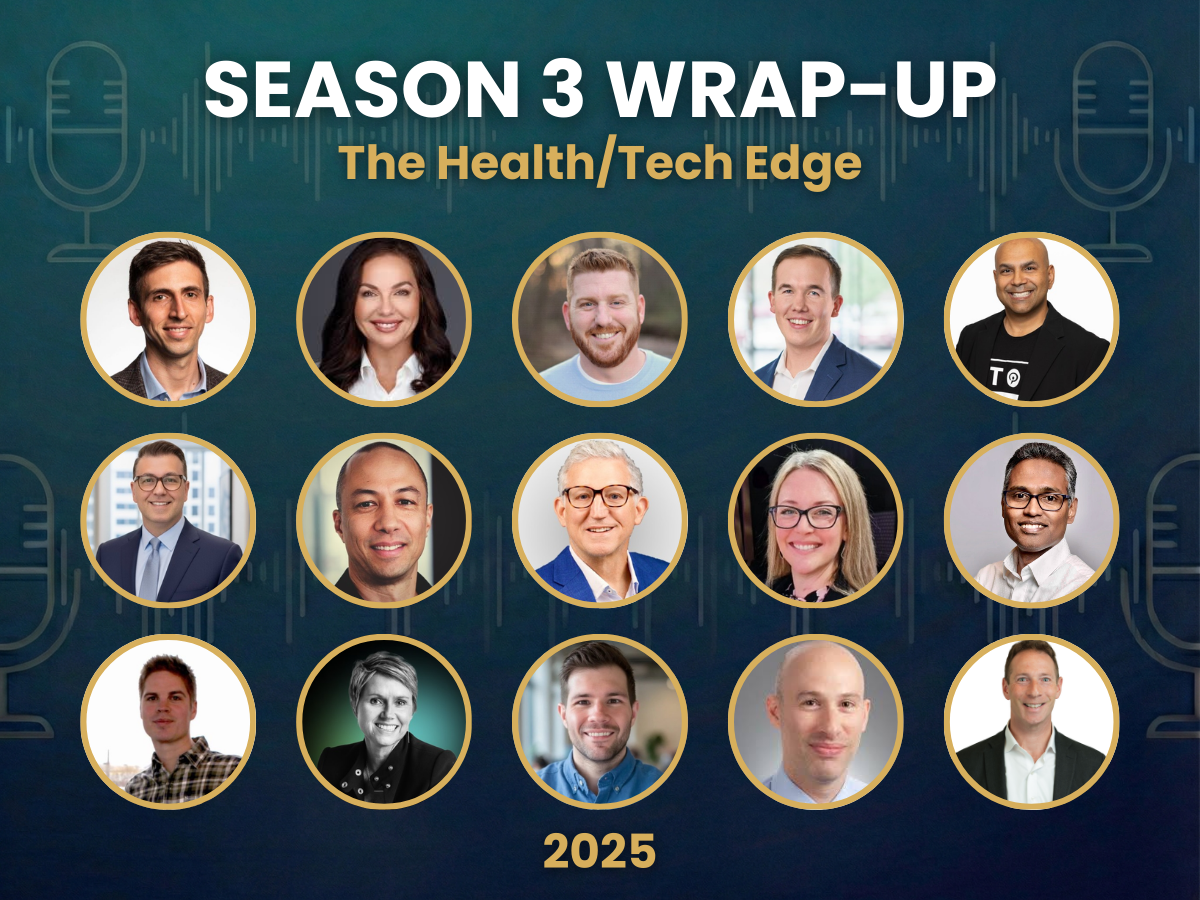The electronic health record (EHR) systems have become a ubiquitous part of modern healthcare and are an essential component of value-based care. However, the challenge of achieving interoperability between different EHR systems has been a longstanding issue, hindering efficient and seamless exchange of health data between providers, hospitals, and other healthcare facilities.
In our recent episode of The Health/Tech Edge, Nick McKenzie, the Group Product Manager at Redox, joined Raheel Retiwalla, Chief Strategy Officer, and Zoe Jacobs, Sr. UX Content Strategist of Productive Edge, to shed light on how his company addresses this challenge by leveraging modern trends in healthcare and data. Redox's solution enables the seamless exchange of information between disparate EHR systems, regardless of language type, providing significant value to the value-based care model. Read on to learn how Redox is revolutionizing data interoperability in electronic health record systems and contributing to the evolution of value-based care.
Zoe: Nick, Electronic Health Record (EHR) data integration is one of the foundational requirements for data interoperability. Can you tell us how Redox came about and how this model enables you to be the EHR data integration choice for so many different use cases?
Nick: Fundamentally, I think Redox approached the problem in the market in a really interesting way. You had so many different EHR companies trying to work their way into different care venues for modernization in the digitization of health record data. Redox looked up and said “we have all these different players who all have their own unique formats, but at the core of it, that's going to make the interoperability or the semantic exchange of that data really difficult”. So what if there was a company out there who approached the market from a reusable infrastructure point of view and built interactions between disparate systems of different language types in a way that a customer could come and have one normalized experience, but then reach those disparate endpoints of different types, leveraging that same reusable infrastructure.
Redox aimed to create reusable and repeatable integrations to enable their customers to easily connect to various endpoints in the healthcare data landscape, without reinventing the wheel. They were early adopters of restful JSON API structures, which became the foundation of their API-first company. These two factors set Redox apart in the market and present a challenging but interesting paradigm. It’s a super interesting paradigm and a tough one to solve.
Raheel: What's interesting about Redox is that you started off by enabling digital health solutions companies that are trying to build on top of the digitization of EHRs and start to offer more customized engagement solutions. I'm curious to hear how many digital health solutions companies have you enabled and how many providers have you connected in these disparate systems?
Nick: In nine years, Redox has connected over 450 digital health tech companies to more than 4,500 unique endpoints, with the heatmap showing an expanding network of connections. Initially focused on independent software vendor connections to healthcare EHRs, our foundational connections have now enabled us to offer access to nationwide networks like Care Quality and Commonwealth. Recently, we have expanded our offerings to include large-scale data exchange for customers choosing cloud hosting providers.
Raheel: I'm curious, do your customers understand the fact that once they've made that connection, they can start turning on other capabilities? Can you give us examples of customers that are doing it well and how others could be thinking more about it?
Nick: Our brand promise streamlines the connection process for customers, allowing them to code once to one of our available API structures and align their stack with the Redox stack to access a robust ecosystem. By leveraging our platform, customers can free up development resources to focus on improving product features, such as digital health solutions for clinicians or expansion and claims data for payers. With customers from 22 different healthcare verticals, our extensive coverage of data models enables efficient exchange of information, providing confidence to digital health tech companies and their customers.
Raheel: How many mid-market health system CIOs, CTOs, and other technology leaders transition to direct engagement with Redox after successfully implementing a digital health solution, to enable additional capabilities like lab results or remote patient monitoring?
Nick: We attract independent software vendors to connect with healthcare organizations, facilitate smooth implementation, and earn positive feedback. This has led to word-of-mouth referrals, where some healthcare organizations recommend Redox as the on-ramp for new health tech vendors. For example, Memorial Care is building a remote patient monitoring ecosystem and has partnered with Redox as part of their care venue expansion.
Our traditional customer base hasn't been healthcare institutions directly, but we've attracted independent software vendors who connect with healthcare organizations. Memorial Care, a healthcare institution, became a direct customer after selecting vendors that we had lit up. They rely on us to deliver multiple solutions and become the on-ramp for their care pathway. This virtuous cycle brings customers to HCLs, and HCLs bring us customers, magnifying network effects.
Healthcare institutions are increasingly selecting large cloud repositories for Artificial Intelligence (AI) and Machine Learning (ML), visualization, and data aggregation. Our recent partnership announcement with Google enables us to work with HCLs at scale, which will positively impact our core business of moving healthcare data directly to their cloud vendor of choice and normalizing it for use in AI/ML algorithms and care modeling.
Raheel: What value does Redox add through its partnership with Google that makes it easier for technology teams in healthcare to consider moving to the cloud?
Nick: To move legacy data, there's a high learning barrier due to the differences in data models between EHRs and the use of fire as the ingress mechanism, storage pattern, and interoperability standard by major cloud vendors, making it difficult to create a longitudinal view of data from different systems.
Redox's main value proposition is its ability to translate various healthcare data standards into usable fire resources, which can then be utilized by tools such as Google's BigQuery and AI/ML algorithms. Redox is also well-positioned to deliver AI/ML insights back to clinicians within their workflow, thus driving care outcomes for patients. Redox is responsible for both the ingress and egress of healthcare data, making it a unique and exciting position to be in.
Raheel: Google, Microsoft, and Amazon are doing some really exciting work with their fire and data models, making it easier for organizations to get started quickly. We've worked with many healthcare companies and know that they don't want to do custom development anymore. They want to turn things on quickly with easy integration, and get into the cloud faster while still maintaining HIPAA compliance and satisfying regulations. Redox and Google partnering up is a great example of how we can make this happen, and we're looking forward to partnering with both of them.
Nick: In healthcare, things are really tough right now. With the pandemic and changes in the industry, healthcare institutions are struggling to make ends meet. They're trying to be more efficient and cut costs wherever they can. So when they invest in new technology solutions, they need to make sure they'll actually get a return on their investment.
Some hospitals have teams of experts who can build their own data tools and algorithms to manage all their information. But most hospitals don't have those kinds of resources. That's where companies like Redox come in. They create pre-built tools that can help healthcare institutions organize and make sense of their data, without needing to hire a whole team of data experts. This is especially important for smaller hospitals that can't afford to invest in expensive data science teams. By using these tools, they can improve patient care and save money without all the hassle.
Zoe: Nick, you’ve worked in healthcare technology for more than 10 years. Can you tell us what's surprised you the most over that time?
Nick: I'm a systems thinker, and I've gone from learning about individual applications to now being exposed to the whole EHR industry through my work at Redox. What surprises me is that despite coming from different backgrounds, everyone in the industry is trying to solve the same thing - making technology easy to interact with and improving patient outcomes. It's impressive how committed people are to this goal, even when they get lost in technical details. At the core of it all, everyone is focused on ensuring that patients receive the best care possible. I'm always surprised by the different angles of the market that prioritize patient outcomes.
Stay Ahead of Trends and Technology Innovation in Healthcare
While the challenge of achieving interoperability between different electronic health record (EHR) systems remains an ingoing challenge in healthcare, companies like Redox have approached this problem in an innovative and interesting way.
By focusing on building reusable and repeatable integrations, Redox has created a platform that enables clients to easily connect to various endpoints in the healthcare data landscape, without the need to reinvent the wheel. While this is a challenging paradigm, the success of companies like Redox demonstrate the potential for new solutions and innovations to tackle the issue of interoperability and improve the efficiency and effectiveness of healthcare.
Want to learn more about the latest disruptors and innovations in healthcare technology and how you can leverage them to create value for your organization and patients? Check out The Health/Tech Edge for the latest episodes featuring industry experts and healthcare providers.


.png)

.png)